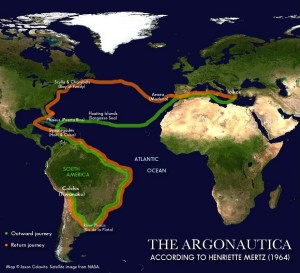Ohio
Stahel, H. R.
Hans Rudolf Stahel is possibly Swiss(a) and an architect by profession, he is also the author of a guide to Atlantis entitled Atlantis Illustrated [560]+, with a foreword by Isaac Asimov. While Stahel located Atlantis in the Atlantic, Asimov opted for the destruction of Thera as the inspiration for Plato’s story.
The illustrations are good but unfortunately are only in black and white. Stahel based all the designs and plans of Atlantis on Plato’s descriptions. His drawings, more than anything else, demonstrate the improbability of dimensions recorded by Plato. The consistent degree of over-engineering forces us to question the accuracy of Plato’s numbers and consider whether this perceived exaggeration is the result of an erroneous transcription of numerals or a misunderstanding of the units of measurement employed.
Stahel depicted Atlantis as a 77,000 square mile island, centred on the Azores with a chain of islands stretching from there to Newfoundland more or less in a straight line. He also envisages an Atlantean Empire stretching from parts of the west coast of America to include the Mississippi, Missouri and Ohio river basins, Central America and as far south as the Amazon basin. East of the capital he includes all of coastal Europe and the Mediterranean (except Greece), along the coast of north and west Africa, the Middle East and on into India. Imaginative if nothing else[p10]!
>Stahel is the only commentator that I have encountered who suggested that elephants were used in the construction of the magnificent buildings described by Plato. This would make sense as Stahel calculated that surrounding the city of Atlantis “the aggregate length of the walls was almost 50 miles; they were 50 feet broad and twice as high. To build them, and their gates and towers, was a feat as impressive as the construction of the canals. The quantity of stone required was roughly 27 times that used in an Egyptian pyramid.” [p94]<
The only other book attributed to H.R. Stahel is Die Pfahlbauer – Entstehung und Geschichte eines Pfahlbaudorfes[1527], which deals with ancient European pile-dwellings that are comparable with the numerous crannogs of Ireland(b).
[560]+ borrow from https://archive.org/details/atlantisillustra00stah *
(a) https://atlantisforschung.de/index.php?title=Hans_Rudolf_Stahel (German)
(b) https://www.enjoy-irish-culture.com/Crannog.html
Mertz, Henriette
Henriette Mertz (1898-1985) During World War II she worked as a code- breaker in the U.S. government’s cryptography department, while later she became an American patent lawyer in Chicago. Her interest in archaeology led her to be the first[0396][0397] to propose that Odysseus, after wandering about the Atlantic, was the earliest European to set foot in America: an idea now taken up by others including Enrico Mattievich[0400].
breaker in the U.S. government’s cryptography department, while later she became an American patent lawyer in Chicago. Her interest in archaeology led her to be the first[0396][0397] to propose that Odysseus, after wandering about the Atlantic, was the earliest European to set foot in America: an idea now taken up by others including Enrico Mattievich[0400].
Mertz recognised that ancient America was host to guests if not residents from both east and west and has written in Pale Ink[0398] on the evidence for the existence of persistent pre-Columbian Chinese contacts. This book was later re-published as a paperback and retitled Gods from the Far East.
Her book The Mystic Symbol[0621] argues that some early Christians fled to America to escape persecution in the Roman Empire. Wayne N. May, the Mormon publisher of Ancient American, has also published a paper on the Mystic Symbol(b).
In a paper reprinted in the Ancient America website, Mertz decried the fact that thousands of inscribed artefacts recovered from mounds in the State of Michigan, between 1890 and 1920, were destroyed, in particular the controversial Newberry Tablet(c).
Her reputation as a serial heretic also forced her to privately publish a volume on Atlantis[0399] following rejection by twenty publishers. She gave a lecture on her views in London in 1964(d) and enjoyed extensive coverage in the Greek press including the serialisation of her book.
Her contention is that Atlantis was located in the southeast of the United States. She begins with the legend of the Seven Cities of Antillia and its depiction on the 1436 map of Andrea Bianco. A comparison of this map with a modern map of Florida convinced her that they referred to the same region. She discusses many aspects of Plato’s story and their compatibility with the archaeology, geography and legends of her chosen location. She also offers a map of Atlantis that encompasses the land bound by the Mississippi, Ohio and Potomac rivers as well as the Atlantic giving us the ‘island’ of Atlantis. To support this possibility she ingeniously suggests that Plato used the word ‘sea’ in the sense of being navigable and so was also applicable to rivers.
Mertz’s book, Wine Dark Sea, which claims that Homer’s Odyssey describes a  very ancient trip to America, inspired the Austrian ethnologist, Christine Pellech, to expand on her work with a number of books on diffusionism together with a website on the subject. Unfortunately, Pellech’s books are only available in German but she has also established an English language magazine and website(a).>However, Pellech references Mertz’s theory but goes further with her contention that Homer’s Odyssey was a description of an ancient circumnavigation of the globe.(e)<
very ancient trip to America, inspired the Austrian ethnologist, Christine Pellech, to expand on her work with a number of books on diffusionism together with a website on the subject. Unfortunately, Pellech’s books are only available in German but she has also established an English language magazine and website(a).>However, Pellech references Mertz’s theory but goes further with her contention that Homer’s Odyssey was a description of an ancient circumnavigation of the globe.(e)<
(a) https://www.migration-diffusion.info/index.php
(b) https://www.migration-diffusion.info/article.php?id=73
(d) Atlantis, Volume 17, No.6, October 1964.
(e) Dr. Christine Pellech – Atlantisforschung.de (German) (See Archive 7097 mixed English & German) *
